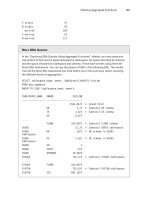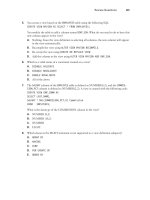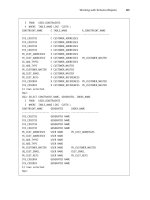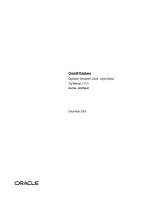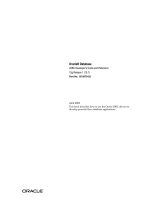Oracle Database Performance and Scalability pptx
Bạn đang xem bản rút gọn của tài liệu. Xem và tải ngay bản đầy đủ của tài liệu tại đây (8.39 MB, 729 trang )
www.it-ebooks.info
Oracle Database
Performance
and Scalability
www.it-ebooks.info
Quantitative Software Engineering Series
The Quantitative Engineering Series focuses on the convergence of systems engi-
neering with emphasis on quantitative engineering trade-off analysis. Each title
brings the principles and theory of programming in-the-large and industrial
strength software into focus.
This practical series helps software developers, software engineers, systems engi-
neers, and graduate students understand and benefit from this convergence through
the unique weaving of software engineering case histories, quantitative analysis,
and technology into the project effort. You will find each publication reinforces the
series goal of assisting the reader with producing useful, well-engineered software
systems.
Series Editor: Lawrence Bernstein
Professor Bernstein is currently an Industry Research Professor at the Stevens
Institute of Technology. He previously pursued a distinguished executive career at
Bell Laboratories. He is a fellow of the IEEE and ACM.
Trustworthy Systems for Quantitative Software Engineering / Larry Bernstein
and C.M. Yuhas
Software Measurement and Estimation: A Practical Approach / Linda M.
Laird and M. Carol Brennan
World Wide Web Application Engineering and Implementation / Steven A.
Gabarro
Software Performance and Scalability / Henry H. Liu
Managing the Development of Software-Intensive Systems / James McDonald
Trustworthy Compilers / Vladimir O. Safonov
Oracle Database Performance and Scalability: A Quantitative Approach /
Henry H. Liu
Enterprise Software Architecture and Design: Entities, Services and
Resources / Dominic Duggan
quantitative software eng new cp_quantitative software eng cp.qxd 8/11/2011 12:06 PM Page 1
www.it-ebooks.info
Oracle Database
Performance
and Scalability
A Quantitative Approach
Henry H. Liu
www.it-ebooks.info
Copyright Ó 2012 by John Wiley & Sons, Inc. All rights reserved
Published by John Wiley & Sons, Inc., Hoboken, New Jersey
Published simultaneously in Canada
No part of this publication may be reproduced, stored in a retrieval system, or transmitted in any form or by
any means, electronic, mechanical, photocopying, recording, scanning, or otherwise, except as permitted
under Section 107 or 108 of the 1976 United States Copyright Act, without either the prior written
permission of the Publisher, or authorization through payment of the appropriate per-copy fee to the
Copyright Clearance Center, Inc., 222 Rosewood Drive, Danvers, MA 01923, (978) 750-8400,
fax (978) 750-4470, or on the web at www.copyright.com. Requests to the Publisher for permission should
be addressed to the Permissions Department, John Wiley & Sons, Inc., 111 River Street, Hoboken,
NJ 07030, (201) 748-6011, fax (201) 748-6008, or online at />Limit of Liability/Disclaimer of Warranty: While the publisher and author have used their best efforts
in preparing this book, they make no representations or warranties with respect to the accuracy or
completeness of the contents of this book and specifically disclaim any implied warranties of
merchantability or fitness for a particular purpose. No warranty may be created or extended by sales
representatives or written sales materials. The advice and strategies contained herein may not be
suitable for your situation. You should consult with a professional where appropriate. Neither the
publisher nor author shall be liable for any loss of profit or any other commercial damages, including but
not limited to special, incidental, consequential, or other damages.
For general information on our other products and services or for technical support, please contact
our Customer Care Department within the United States at (800) 762-2974, outside the United States
at (317) 572-3993 or fax (317) 572-4002.
Wiley also publishes its books in a variety of electronic formats. Some content that appears in print may
not be available in electronic formats. For more information about Wiley products, visit our web site at
www.wiley.com.
Library of Congress Cataloging-in-Publication Data:
Liu, Henry H.
Oracle database performance and scalability : a quantitative approach /Henry H. Liu.
p. cm.
ISBN 978-1-118-05699-8 (cloth)
1. Oracle (Computer file) 2. Database management. I. Title.
QA76.9.D3L5945 2012
005.75’65–dc23
2011017552
Printed in the United States of America
oBook ISBN: 978-1-118-13553-2
ePDF ISBN: 978-1-118-13549-5
ePub ISBN: 978-1-118-13551-8
eMobi ISBN: 978-1-118-13550-1
10987654321
www.it-ebooks.info
To My Family
www.it-ebooks.info
www.it-ebooks.info
Contents
PREFACE xxv
Why This Book / xxv
Who This Book is For / xxvi
How This Book is Organized / xxvii
Software and Hardware / xxviii
How to Use This Book / xxix
How to Reach The Author / xxxi
ACKNOWLEDGMEN TS xxxiii
INTRODUCTION 1
Features of Oracle / 2
Objectives / 4
Conventions / 5
Performance versus Scalability / 6
PART 1 GETTING STAR TED WITH ORACLE 7
1 Basic Concepts 9
1.1 Standard versus Flavored SQLS / 10
1.2 Relational versus Object-Oriented Databases / 11
vii
www.it-ebooks.info
1.3 An Instance versus a Database / 11
1.4 Summary / 12
Recommended Reading / 12
Exercises / 12
2 Installing Oracle Software 14
2.1 Installing Oracle 11g Server So ftware / 15
2.2 Configuring a Listener / 18
2.3 Creating an Oracle Database / 18
2.4 Installing Oracle 11g Client Software / 28
2.5 Oracle Grid Control versus DB Control / 31
2.6 Summary / 33
Recommended Reading / 33
Exercises / 33
3 Options for Accessing an Oracle Server 34
3.1 A Command Line Interface (CLI) versus
a GUI-Based Console / 35
3.2 The Oracle Enterprise Manager Java Console
(OEMJC) / 37
3.3 Using the SQL
Ã
Plus Tool / 40
3.4 Oracle Enterprise Mana ger DBConsole / 42
3.5 Other Tools for Developers / 43
3.6 Case Study: Creating ER Diagrams with Visio via
ODBC / 44
3.7 Case Study: Accessing Oracle in Java via JDBC / 47
3.8 Summary / 49
Recommended Reading / 50
Exercises / 50
4 A Quick Tour of an Oracle Server 52
4.1 New Oracle Schemas Beyond “Scott” / 53
4.2 Oracle Users versus Schemas / 54
4.3 Tablespaces, Segments, Extents, and Data Blocks / 56
4.4 Tables, Indexes and Index Types for Structured Data / 57
4.5 Domain and LOB Index Types for Unstructured Data / 65
4.6 Views, Materialized Views, and Synonyms / 68
4.7 Stored Procedures, Funct ions, and Triggers / 68
4.8 Referential Integrity with Foreign Keys / 71
4.9 Summary / 73
viii CONTENTS
www.it-ebooks.info
Recommended Reading / 73
Exercises / 74
PART 2 ORACLE ARCHITECTURE FROM PERFORMANCE
AND SCALABILITY PERSPECTIVES 75
5 Understanding Oracle Architecture 79
5.1 The Version History of Oracle / 80
5.2 Oracle Processes / 82
5.3 Oracle Memory Areas / 87
5.4 Dedicated versus Shared Oracle Server Architecture / 89
5.5 Performance Sensitive Initialization Parameters / 91
5.6 Oracle Static Data Dictionary Views / 94
5.7 Oracle Dynamic Perform ance (V$) Views / 95
5.8 Summary / 98
Recommended Reading / 98
Exercises / 99
6 Oracle 10g Memory Management 101
6.1 SGA Sub-Areas / 102
6.2 SGA Sizing: Automatic Shared Memory Managem ent
(ASMM) / 104
6.3 PGA Sizing: PGA_AGGREGATE_TARGET / 106
6.4 Summary / 108
Recommended Reading / 109
Exercises / 110
7 Oracle 11g Memory Management 111
7.1 Automatic Memory Management (AMM) / 112
7.2 Memory Sizing Options Configurable at Database
Creation Time / 112
7.3 Checking Memory Management and Usage Distribution
at Run Time / 113
7.4 Summary / 115
Recommended Reading / 115
Exercises / 115
8 Oracle Storage Structure 116
8.1 Overview / 117
8.2 Managing Tablespaces / 119
CONTENTS ix
www.it-ebooks.info
8.3 Managing Data Files / 122
8.4 Managing Redo Logs / 124
8.5 Summary / 125
Recommended Reading / 125
Exercises / 126
9 Oracle Wait Interface (OWI) 127
9.1 Ratio-based versus OWI-based Oracle Performance
Tuning Methodologies / 128
9.2 Wait Event—The Core Concept
of OWI / 130
9.3 Classification of Wait Events from
OWI / 131
9.4 The Other Part (CPU Time) of the Equation Elapsed
Time ¼ CPU Time þ Wait Time / 134
9.5 AWR as a Compass to Tuning Oracle Performance and
Scalability / 136
9.6 Summary / 137
Recommended Reading / 137
Exercises / 138
10 Oracle Data Consistency and Concurrency 139
10.1 Select for Update Statement / 140
10.2 ACID Properties of Transactions / 141
10.3 Read Phenomena and Data Inconsistencies / 143
10.4 Oracle Isolation Levels / 145
10.5 Multi-Version Concurrency Control (MVCC) and
Read Consistency / 145
10.6 Oracle Locks / 146
10.7 Lock Escalations versus Conversions / 149
10.8 Oracle Latches / 149
10.9 Oracle Enqueues / 150
10.10 Deadlocks / 150
10.11 Taking Advantage of Oracle’s Scalable Concurrency
Model / 151
10.12 Case Study: A JDBC Example / 152
10.13 Summary / 158
Recommended Reading / 159
Exercises / 159
x CONTENTS
www.it-ebooks.info
11 Anatomy of an Oracle Automatic Workload Repository
(AWR) Report 161
11.1 Importance of Performance Statistics / 162
11.2 AWR Report Header / 165
11.3 Report Summary / 166
11.3.1 Cache Sizes / 166
11.3.2 Load Profile / 167
11.3.3 Instance Efficiency Percentages
(Target 100%) / 169
11.3.4 Shared Pool Statistics / 170
11.3.5 Top Five Timed Events / 170
11.4 Main Report / 171
11.5 Wait Events Statistics / 172
11.5.1 Time Model Statistics / 173
11.5.2 Wait Class / 174
11.5.3 Wait Events / 174
11.5.4 Background Wait Events / 176
11.5.5 Operating System Statistics / 176
11.5.6 Service Statistics / 177
11.5.7 Service Wait Class Stats / 178
11.6 SQL Statistics / 178
11.6.1 SQL ordered by Elapsed Time / 179
11.6.2 SQL ordered by CPU Time / 180
11.6.3 SQL ordered by Gets / 180
11.6.4 SQL ordered by Reads / 181
11.6.5 SQL ordered by Executions / 182
11.6.6 SQL ordered by Parse Calls / 183
11.6.7 SQL ordered by Sharable Memory / 183
11.6.8 SQL ordered by Version Count / 183
11.6.9 Complete List of SQL Text / 184
11.7 Instance Activity Statistics / 185
11.7.1 Instance Activity Stats / 185
11.7.2 Instance Activity Stats—Absolute Values / 196
11.7.3 Instance Activity Stats—Thread Activity / 197
11.8 IO Stats / 197
11.8.1 Tablespace IO Stats / 198
11.8.2 File IO Stats / 198
11.9 Buffer Pool Statistics / 199
11.10 Advisory Statistics / 199
11.10.1 Instance Recovery Stats / 200
11.10.2 Buffer Pool Advisory / 200
11.10.3 PGA Aggr Summary / 201
11.10.4 PGA Aggr Target Stats / 202
CONTENTS xi
www.it-ebooks.info
11.10.5 PGA Aggr Target Histogram / 202
11.10.6 PGA Memory Advisory / 203
11.10.7 Shared Pool Advisory / 204
11.10.8 SGA Target Advisory / 204
11.10.9 Streams Pool Advisory / 205
11.10.10 Java Pool Advisory / 205
11.11 Wait Statistics / 206
11.12 Undo Statistics / 207
11.13 Latch Statistics / 208
11.13.1 Latch Activity / 208
11.13.2 Latch Sleep Breakd own / 213
11.13.3 Latch Miss Sources / 214
11.13.4 Parent and Child Latch Statistics / 215
11.14 Segment Statistics / 215
11.14.1 Segments by Logical Reads / 215
11.14.2 Segments by Physical Reads / 216
11.14.3 Segments by Row Lock Waits / 217
11.14.4 Segments by ITL Waits / 217
11.14.5 Segments by Buffer Busy Waits / 217
11.15 Dictionary Cache Stats / 218
11.16 Library Cache Activity / 219
11.17 Memory Statistics / 219
11.17.1 Process Memory Summary / 219
11.17.2 SGA Memory Summary / 220
11.17.3 SGA Breakdown Difference / 221
11.18 Streams Statistics / 222
11.19 Resource Limit Stats / 224
11.20 init.ora Parameters / 224
11.21 Summary / 225
Recommended Reading / 225
Exercises / 226
12 Oracle Advanced Featur es and Options 227
12.1 Oracle 8i New Features / 227
12.1.1 Java / 228
12.1.2 Oracle interMedia, Spatial, Time Series, and Visual
Image Retrieval / 229
12.1.3 Oracle Parallel Server / 230
12.1.4 Optimizer Plan Stability / 230
12.1.5 Locally Managed Tablespaces / 230
12.1.6 Online Index Creation and Rebuild / 231
12.1.7 Online Read-Only Tablespaces / 231
xii CONTENTS
www.it-ebooks.info
12.1.8 Temporary Tables / 231
12.1.9 Non-Blocking OCI (Oracle Call Interface) / 231
12.1.10 Function-Based Indexes / 232
12.1.11 Logical ROWIDs / 232
12.1.12 Enhanced Partitioning / 232
12.1.13 Connection Load Balancing / 233
12.1.14 Client Load Balancin g / 233
12.1.15 Oracle Enterprise Manager / 233
12.2 Oracle 9i New Features / 233
12.2.1 Real Application Clusters (RAC) / 234
12.2.2 Data Guard / 236
12.2.3 Performance Tuning Intelligent Advisors / 239
12.2.4 Actual Operation-Level Query Statistics / 239
12.2.5 Dynamic Sampling of Optimizer Statistics / 239
12.2.6 Cloning Production Database with Oracle
Enterprise Manager / 240
12.2.7 Renaming Columns and Constraints / 241
12.2.8 Dynamic Memory Pools / 241
12.2.9 Flashback Query / 241
12.2.10 List Partitioning / 241
12.3 Oracle 10g New Features / 241
12.3.1 Automatic Storage Management (ASM) / 242
12.3.2 Asynchronous Commit / 244
12.3.3 Database Replay / 244
12.3.4 Read Performance Statistics Directly from the
SGA / 245
12.3.5 Automatic Workload Repository (AWR) / 245
12.3.6 Automatic Database Diagnostic Monitor
(ADDM) / 245
12.3.7 Automatic Shared Memory Tuning / 245
12.3.8 Automatic Optimizer Statistics Gathering / 245
12.3.9 SQL Tuning Features / 247
12.3.10 Grid Computing / 247
12.4 Oracle 11g New Features / 248
12.4.1 Automatic Memory Management / 249
12.4.2 Intelligent Cursor Sharing / 249
12.4.3 Database Resident Connection Pool
(DRCP) / 249
12.4.4 Server Result Cache / 250
12.4.5 Database Smart Flash Cache / 251
12.4.6 Database Replay SQL Performance Analyzer
(SPA) Integration / 252
12.4.7 I/O Calibration / 252
12.4.8 Partitioning Enhancements / 252
CONTENTS xiii
www.it-ebooks.info
12.4.9 SQL Plan Management / 253
12.4.10 Zero-Size Unusable Indexes and Index
Partitions / 254
12.4.11 Invisible Indexes / 254
12.4.12 Virtual Columns / 254
12.5 Summary / 255
Recommended Reading / 255
Exercises / 255
13 Top 10 Oracle Performance and Scalability Features 257
13.1 Real Application Clustering (RAC) / 258
13.2 Dedicated versus Shared Server Models / 260
13.3 Proven Transaction and Concurrency Models / 260
13.4 A Highly Efficient SQL Optimization Engine / 261
13.5 Efficient Parallel Processing with Modern Multi-Core
CPUs / 261
13.6 Partitioning / 262
13.7 An All-Encompassing, Powerful Performance,
and Scalability Troubleshooting Tool—AWR / 262
13.8 The Most Comprehensive Set of Internal Performance
Metrics / 263
13.9 Database Resident Connection Pool / 263
13.10 In-Memory Database Cache (IMDB) / 263
13.11 Summary / 263
Recommended Reading / 264
Exercises / 264
14 Oracle-Based Application Performance and Scalability
by Design 266
14.1 Rapid Development Methodologies / 268
14.2 Planning / 269
14.2.1 Vision / 269
14.2.2 Objectives / 270
14.2.3 ROI Analysis / 270
14.2.4 Feasibility Study / 271
14.2.5 Project Team Formation / 271
14.3 Requirements Gathering / 272
14.3.1 Use Cases / 273
14.3.2 User Views / 274
14.3.3 Business Processes, Entities, and Business
Rules / 274
xiv CONTENTS
www.it-ebooks.info
14.4 Conceptual Design via Data Modeling / 275
14.4.1 Entity-Relationship Diagramming / 276
14.4.2 The Information Engineering (IE) Format for
ERDs / 278
14.4.3 UML Format for ERDs / 279
14.4.4 Relational Format for ERDs / 279
14.5 Logical Design via Normalization / 280
14.5.1 Operational Anomalies / 281
14.5.2 Review of Relation Theory / 282
14.5.3 Functional Dependencies and Lossless-Join
Decompositions / 285
14.5.4 First Normal Form (1NF): Avoiding
Multi-Valued Columns / 287
14.5.5 Second Normal Form (2NF): Eliminating
Partial Dependencies / 288
14.5.6 Third Normal Form (3NF): Eliminating
Transitive Dependencies: / 288
14.5.7 Boyce-Codd Normal Form (BCNF): Eliminating
Key—Non-Key Dependencies / 289
14.5.8 Fourth Normal Form (4NF): Trivializing or Keying
Multi-Valued Dependencies / 290
14.5.9 Fifth Normal Form (5NF): Trivializing or Keying
Join Dependencies / 292
14.5.10 Which Level of Normalization to Settle
Down? / 294
14.5.11 Denormalization? / 294
14.6 Physical Design / 295
14.6.1 Naming Conventions / 297
14.6.2 Creating Tablespaces / 298
14.6.3 Creating a Schema User with Proper
Privileges / 299
14.6.4 Creating Application Schema Objects / 299
14.6.5 Changing Schema Objects / 308
14.6.6 Enforcing Business Rules and Data
Integrity / 309
14.6.7 Adding Views / 312
14.6.8 Creating Sequences and Synonyms / 312
14.6.9 Adding Indexes / 313
14.6.10 Security / 314
14.7 Implementation / 315
14.7.1 Choosing an Effective and Efficient Coding
Path / 315
14.7.2 Leveraging Proven Oracle Database Design
Principles / 316
CONTENTS xv
www.it-ebooks.info
14.7.3 Leveraging Proven Application Design
Patterns / 318
14.7.4 Enforcing with an Effective and Efficient Testing
Process / 319
14.8 Release To Market (RTM) / 322
14.9 Continuous Improvements / 322
14.10 Summary / 323
Recommended Reading / 324
Exercises / 325
15 Project: Soba—A Secure Online Banking Application
on Oracle 326
15.1 Getting SOBA Up and Running / 328
15.1.1 Prerequisite Software / 328
15.1.2 Initial Software Stack Setup / 329
15.1.3 Creating SOBA Database on Oracle / 330
15.1.4 Installing SOBA on Eclipse IDE / 330
15.1.5 Configuring SOBA to Work with Oracle / 331
15.1.6 Configuring SOBA to Work with
Hibernate / 333
15.1.7 Building SOBA and Deploying SOBA with
Ant to Run on Tomcat / 333
15.2 Overview of Spring Framework / 333
15.2.1 Background / 333
15.2.2 Spring for Building Flexible Applications
Faster / 334
15.2.3 Spring Inversion of Control (IoC) and
Dependency Injection / 335
15.2.4 Features of Spring 3.0 / 336
15.3 MVC Architecture / 337
15.3.1 MVC Architecture in General / 338
15.3.2 Spring MVC in Action with SOBA / 340
15.4 Spring MVC Framework Applied to SOBA / 342
15.4.1 Spring DispatcherServlet and
WebApplicationContext / 343
15.4.2 Logic Flow of SOBA Defined in Spring
MVC Framework / 347
15.4.3 A Web Entry Point Defined in a Spring
MVC Web Form / 348
15.4.4 Handler Mapping / 350
15.4.5 Implementing Spring Controllers / 353
15.4.6 A Typical View Defined in a Spring MVC Web
Form / 358
xvi CONTENTS
www.it-ebooks.info
15.4.7 A Typical Form Success Controller and its
Resultant View / 362
15.4.8 POJOs Referenced in the
CreateCustomerFormController / 364
15.5 Hibernate Object-Relational Mapping (ORM) Applied
to SOBA / 368
15.5.1 Benefits of Using Hibernate / 369
15.5.2 Metadata Mapping with Hibernate / 370
15.5.3 Configuring Hibernate to Work with
Oracle / 371
15.5.4 Hibernate DAO / 373
15.6 RESTful Web Services Applied to SOBA / 376
15.6.1 Introduction to RESTful Web Services / 376
15.6.2 RESTful Constraints / 377
15.6.3 RESTful Interface Design Principles / 378
15.6.4 Spring’s Support for RESTful Web
Services / 379
15.6.5 Server Code / 380
15.6.6 Client Code / 383
15.7 Spring Security Applied to SOBA / 386
15.7.1 Basic Concepts / 387
15.7.2 Security Configured in web.xml / 387
15.7.3 Security Configured in soba-security.xml / 388
15.7.4 Implementing Spring Security in Views / 394
15.8 Spring ACL Applied to SOBA / 394
15.8.1 Creating ACL Tables in Oracle / 395
15.8.2 Configuring Spring ACL / 395
15.8.3 Maintaining ACLs for SOBA Domain
Objects / 398
15.8.4 Applying ACLs to Business
Operations / 404
15.8.5 Testing ACLs with SOBA / 406
15.9 Summary / 413
Recommended Reading / 414
Exercises / 414
PART 3 OPTIMIZING ORACLE PERFORMANCE
AND SCALABILITY 415
16 Logistics of the Oracle Cost-Based Optimizer (CBO) 417
16.1 Life of a SQL Statement in Oracle / 418
16.2 Oracle SQL Optimizer: Rule-Based versus
Cost-Based / 420
CONTENTS xvii
www.it-ebooks.info
16.3 CBO Statistics / 421
16.4 Pivot Role of Gathering Database Statistics to CBO / 422
16.5 Methods of Gathering CBO Statistics / 424
16.6 Locking and Unlocking CBO Statistics / 425
16.7 Explain Plan—A Handle to CBO / 425
16.8 Data Access Methods—CBO’s Footprints / 426
16.9 Looking Up CBO’s Plan Hidden in V$SQL_PLAN / 427
16.10 When CBO may Generate Suboptimum
Execution Plans / 428
16.11 Summary / 429
Recommended Reading / 429
Exercises / 430
17 Oracle SQL Tuning 431
17.1 Tuning Joins / 432
17.2 Tuning Subqueries / 437
17.3 Case Study: Performance of SUBQUERY versus
JOIN / 439
17.4 Case Study: Performance of IN versus EXISTS / 443
17.5 Case Study: A SQL Tuning Yielded a 12x Performance
Gain / 444
17.6 Summary / 447
Recommended Reading / 447
Exercises / 448
18 Oracle Indexing 449
18.1 Rules of Thumb on Indexing / 450
18.2 Creating and Using Ubiquitous b-Tree Indexes / 451
18.3 Advanced Indexing Scheme I: Covering Indexes versus
Index-Organized Tables / 452
18.4 Advanced Indexing Scheme II: Function-Based Indexes
(FBIs) / 453
18.5 Unusual Indexing Scheme I: BITMAP Indexes / 454
18.6 Unusual Indexing Scheme II: Reverse Key Indexes / 455
18.7 Unusual Indexing Scheme III: Compressed Composite
Indexes / 455
18.8 How To Create Oracle Indexes / 456
18.9 Summary / 457
Recommended Reading / 458
Exercises / 458
xviii CONTENTS
www.it-ebooks.info
19 Auto_Tune Features 459
19.1 Oracle Automatic Database Diagnostic Monitor
(ADDM) / 460
19.2 Automatic Undo Management / 462
19.3 Data Recovery Advisor / 462
19.4 Memory Advisors / 462
19.5 MTTR Advisor / 466
19.6 Segment Advisor / 466
19.7 SQL Advisors / 467
19.8 SQL Performance Analyzer / 469
19.9 Summary / 470
Recommended Reading / 471
Exercises / 471
PART 4 CASE STUDIES: ORACLE MEETING REAL WORLD
PERFORMANCE AND SCALABILITY CHALLENGES 473
20 Case Study: Achieving High Throughput with Array
Processing 477
20.1 Context / 478
20.2 Performance Model / 479
20.3 Tests / 480
20.4 Solution / 480
20.5 Effects of Array Processing / 482
20.6 Summary / 484
Recommended Reading / 484
Exercises / 484
21 Case Study: Performance Comparison of Heap-Organized
versus Index-Organized Tables 485
21.1 Context / 486
21.2 Conversion from Heap-Organized to Index-Organized /
487
21.3 Creating Indexes / 487
21.4 Creating Constraints / 488
21.5 EXPLAIN PLANs / 488
21.6 Oracle SQL Traces / 489
21.7 Summary / 490
Recommended Reading / 491
Exercises / 491
CONTENTS xix
www.it-ebooks.info
22 Case Study: SQL Tuning: “IN” versus “OR” versus
Global Temporary Table 492
22.1 Context / 493
22.2 Test Program / 494
22.3 Observation 1: IN_CreateStatement is the Best
Performer / 495
22.4 Observation 2: Batch Insert Saves Time / 497
22.5 Temptable Performed Better without an Index Hint than with
an Index Hint / 498
22.6 Effects of APPEND Hint for Populating Temptable / 499
22.7 Effects of Number of Iterations / 499
22.8 OR and IN without the Index Hint / 499
22.9 Limitation on the Number of Literal Values and the Size of
OR Statement / 501
22.10 Dealing with More Than 1000 Literal Value s for an IN Based
SQL Query / 501
22.11 A Recommendation for Dealing with 1000 Literal Value
Limit in an IN Statement / 501
22.12 Summary / 502
Recommended Reading / 503
Exercises / 503
23 Case Study: Data Access Paths (Double Buffering) 504
23.1 Data Access Paths in General / 505
23.1.1 Data Buffering / 507
23.1.2 Inode Locking / 509
23.1.3 Write-Sync Daemon / 510
23.2 Test Environments / 511
23.2.1 Solaris on Veritas / 511
23.2.2 Solaris on UFS / 511
23.2.3 Windows on NTFS / 512
23.3 Test Results with Solaris on Veritas / 514
23.3.1 Test Run #1—145 ms Average Read Time / 514
23.3.2 Test Run #2—401 ms Average Read Time / 516
23.3.3 Test Run #3—261 ms Average Read Time / 518
23.3.4 Test Run #4—0.98 ms Average Read Time / 519
23.3.5 Analysis / 521
23.4 Test Results with Solaris on UFS / 522
23.4.1 Test Run #1—447 ms Average Read Time / 522
23.4.2 Test Run #2—10ms Average Read Time / 524
23.4.3 Analysis / 525
xx CONTENTS
www.it-ebooks.info
23.5 Test Results with Windows on NTFS / 526
23.5.1 Test Run—8 ms Average Read Time / 526
23.5.2 Analysis / 528
23.6 Moral of the Case Study / 528
Recommended Reading / 529
Exercises / 530
24 Case Study: Covering Index 531
24.1 Getting to Know the Application Architecture / 533
24.2 Quantifying the Problems / 533
24.3 Analyzing Bottlenecks / 533
24.4 Applying Optimizations/Tunings / 535
24.5 Verifying the Fixes / 535
24.5.1 Report Summary / 537
24.5.2 Wait Events Statistics / 538
24.5.3 SQL Statistics / 541
24.5.4 IO Stats / 544
24.5.5 Buffer Pool Statistics / 544
24.5.6 Wait Statistics / 544
24.5.7 init.ora Parameters / 545
24.6 Moral of the Case Study / 545
Recommended Reading / 546
Exercises / 546
25 Case Study: CURSOR_SHARING 547
25.1 The Concept of a Bind Variable / 548
25.2 Oracle CURSOR_SHARING Parameter / 549
25.3 Getting to Know the Application Architecture / 550
25.4 Quantifying Problems / 550
25.5 Analyzing Bottlenecks / 551
25.5.1 Report Summary / 552
25.5.2 SQL Statistics / 556
25.5.3 IO Stats / 557
25.5.4 Wait Statistics / 558
25.5.5 init.ora Parameters / 558
25.6 Applying Tuning: CURSOR_SHARING = FORCE / 560
25.6.1 Report Summary / 561
25.6.2 Wait Events Statistics / 563
25.7 Applying Tuning: CURSOR_SHARING = SIMILAR / 564
25.7.1 Report Summary / 564
25.7.2 Wait Events Statistics / 566
CONTENTS xxi
www.it-ebooks.info
25.8 Moral of the Case Study / 569
Recommended Reading / 569
Exercises / 570
26 Case Study: Bulk Transactions 571
26.1 Application Architecture / 572
26.2 Quantifying Problems / 572
26.3 Identifying Performance and Scalability Optimization
Opportunities / 573
26.3.1 Report Summary / 573
26.3.2 Wait Events Statistics / 575
26.3.3 SQL Statistics / 577
26.3.4 Wait Statistics / 579
26.4 Effects of Bulk Transactions on Performance / 581
26.4.1 Report Summary / 581
26.4.2 Wait Events Statistics / 583
26.4.3 SQL Statistics / 585
26.4.4 Wait Statistics / 587
26.5 Moral of the Case Study / 592
Recommended Reading / 593
Exercises / 593
27 Case Study: Missing Statistics 594
27.1 Decaying Performance due to Missing Statistics / 595
27.2 First Run with no Statistics / 597
27.2.1 Report Summary / 598
27.2.2 Wait Events Statistics / 599
27.2.3 SQL Statistics / 601
27.2.4 IO Stats / 602
27.2.5 Wait Statistics / 602
27.2.6 init.ora Parameters / 603
27.3 Second Run with Missing Statistics / 604
27.3.1 Report Summary / 605
27.3.2 Wait Events Statistics / 606
27.3.3 SQL Statistics / 607
27.3.4 IO Stats / 609
27.3.5 Wait Statistics / 609
27.4 Third Run with Updated Statistics / 611
27.4.1 Report Summary / 611
27.4.2 Wait Events Statistics / 613
27.4.3 Operating System Statistics / 614
27.4.4 SQL Statistics / 614
xxii CONTENTS
www.it-ebooks.info
27.4.5 Wait Statistics / 616
27.5 Moral of the Case Study / 618
Recommended Reading / 618
Exercises / 618
28 Case Study: Misconfigured SAN Storage 620
28.1 Architecture of the Apple’s Xserve RAID / 621
28.2 Problem Analysis / 622
28.2.1 Report Summary / 622
28.2.2 Wait Events Statistics / 624
28.2.3 IO Stats / 625
28.2.4 init.ora Parameters / 625
28.3 Reconfiguring the RAID and Verifying / 626
28.3.1 Report Summary / 626
28.3.2 Wait Events Statistics / 628
28.3.3 IO Stats / 629
28.4 Moral of the Case Study / 629
Recommended Reading / 630
Exercises / 630
APPENDIX A ORACLE PRODUCT DOCUMENTATIONS 633
A.1 Oracle Database Concepts / 633
A.2 Oracle Database Administrator’s Guide / 633
A.3 Oracle Database Reference / 634
A.4 Oracle Database Performance Tuning Guide / 634
A.5 Oracle Database 2 Day þ Performance Tuning
Guide / 634
A.6 Oracle Database 2 Day DBA / 634
A.7 Oracle Database SQL Language Reference / 634
A.8 Oracle Database Sample Schemas / 635
A.9 Oracle Database PL/SQL Packages and Types
Reference / 635
A.10 Oracle Database PL/SQL Language Reference / 635
A.11 Oracle Database JDBC Developer’s Guide and
References / 635
APPENDIX B USING SQL
Ã
PLUS WITH ORACLE 636
B.1 Installation / 636
B.2 SQL
Ã
Plus and tnsnames.ora File / 637
B.3 Basics of SQL
Ã
Plus / 638
CONTENTS xxiii
www.it-ebooks.info
B.4 Common SQL
Ã
Plus Commands / 638
B.5 Using SQL
Ã
Plus to Execute SQL Statements / 639
B.6 Using SQL
Ã
Plus to Execute PL/SQL Blocks / 640
B.7 Using SQL
Ã
Plus Autotrace to Obtain EXECUTION PLANs
and Optimizer Statistics / 640
B.8 Using SQL
Ã
Plus Timing Command / 641
B.9 Exporting/Importing Oracle Databases with
SQL
Ã
Plus / 642
B.10 Creating AWR Reports with SQL
Ã
Plus / 643
B.11 Checking Tablespace Usage with SQL
Ã
Plus / 644
B.12 Creating EM DBConsole with SQL
Ã
Plus / 646
APPENDIX C A COMPLETE LIST OF ALL WAIT EVENTS IN
ORACLE 11g 648
APPENDIX D A COMPLETE LIST OF ALL METRICS WITH
THE V$STATNAME VIEW 656
APPENDIX E A COMPLETE LIST OF ALL STATISTICS WITH
THE V$SYSSTAT VIEW 667
INDEX 681
xxiv CONTENTS
www.it-ebooks.info




